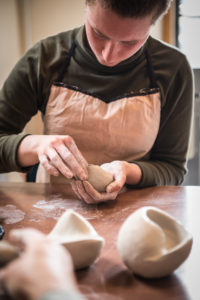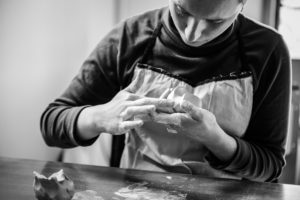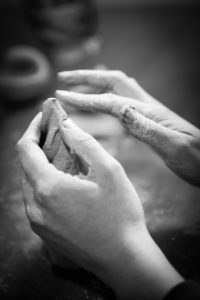The language of Form:
Convex, concave and flat surfaces are for sculpture what the three primary colours are for painting. They each have their own qualities. With all the variations and combinations of these three gestures, we have endless possibilities to express ideas and feelings in form.
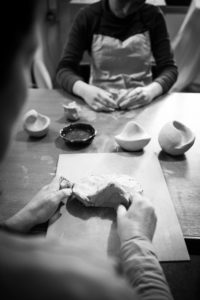
In its raw form clay, wood, stone… are pure matter, lifeless and at the mercy of gravity. It is only through our own doing, our own will, that we change that matter. We ‘trans-form’ it, bring it into levity, into a seemingly living state. We elevate it and make it ‘speak’ an idea.
Sculpture works with the sense of touch. The clay and water on our hands is a gentle way of stimulating this.
Our skin, the organ for our sense of touch, tells us about the boundary between ourselves and the world, where do I end and the world begins. When sculpting, we only ever work on the surface of our forms, on the boundary between what is in the inside the form and the space around it, the outside, and so helps us to strengthen our own sense of boundary.
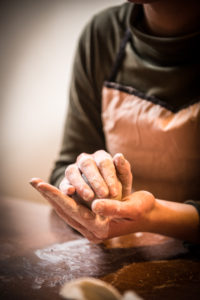
It helps us to gather and focus our attention. Both children and adults can benefit from this in a time when we are constantly drawn out into a world full of sense impressions, it gives us time to slow down.
Developing our inner sense of form, listening to the dialogue between the emerging form and sculptor, develops our senses of movement and balance. We constantly read our work, and sense where it is in proportion or not, where it needs adjusting till it ‘feels’ just right.
When working with clay, we are asked to come into relationship with it. In the virtual reality, we can ‘make things happen’ with the click of a button, with minimal movement, no resistance and without any delay, ‘success is instant’. The clay asks of me to become aware of the interaction between me and the material. How hard do I need to push, where to give support to the soft clay, how to build things slowly over time, in order to achieve the form I want to achieve? I need to feel it, to listen to it, to interact with it, to react to what is happening in my own hands when I want to transform the clay into a form.
This coming into relationship, listening to reactions, knowing where my own actions have an impact and learning to moderate them, are skills that we learn in our doing so they can also become social skills.
Metamorphosis is more than growth, it is a new impulse that changes the direction something goes in. It is a trans-formation.
Life offers continual opportunities for metamorphosis and practicing through sculpture builds skills for life, through trans-forming ourselves and so, how we can stand in the world.
Please click here for some photos of clients work: Gallery clients work
Please click here for testimonials about sculpture therapy: Testimonials

